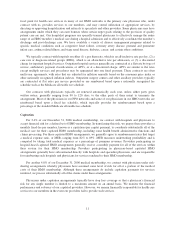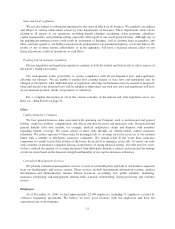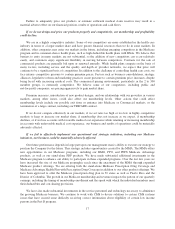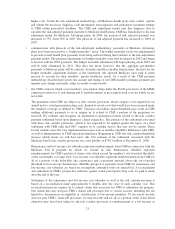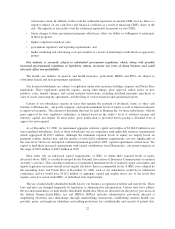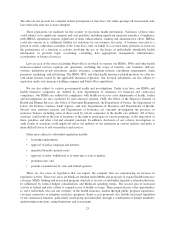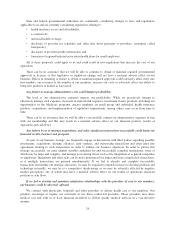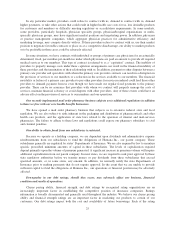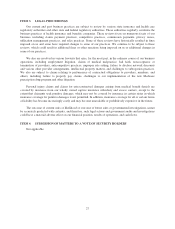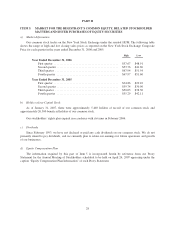Humana 2006 Annual Report Download - page 33
Download and view the complete annual report
Please find page 33 of the 2006 Humana annual report below. You can navigate through the pages in the report by either clicking on the pages listed below, or by using the keyword search tool below to find specific information within the annual report.higher costs. Under the risk adjustment methodology, all Medicare health plans must collect, capture
and submit the necessary diagnosis code information from inpatient and ambulatory treatment settings
to CMS within prescribed deadlines. The CMS risk adjustment model uses this diagnosis data to
calculate the risk adjusted premium payment to Medicare health plans. CMS has transitioned to the risk
adjustment model for Medicare Advantage plans. In 2006, the portion of risk adjusted payment was
increased to 75% from 50% in 2005. The phase-in of risk adjusted payment has increased to 100% in
2007;
• commensurate with phase-in of the risk-adjustment methodology, payments to Medicare Advantage
plans have been increased by a “budget neutrality” factor. The budget neutrality factor was implemented
to prevent overall health plan payments from being reduced during the transition to the risk-adjustment
payment model. The payment adjustments for budget neutrality were first developed in 2002 and began
to be used with the 2003 payments. The budget neutrality adjustment will begin phasing out in 2007 and
will be fully eliminated by 2011. This does not mean, however, that the aggregate per-member
payments to Medicare plans will be reduced. As plans enroll less healthy beneficiaries, the need for the
budget neutrality adjustment declines as the underlying risk adjusted Medicare rates paid to plans
increase to account for their enrollees’ greater healthcare needs. As a result of the CMS payment
methodology described previously, the amount and timing of our CMS monthly premium payments per
member may change materially, either favorably or unfavorably;
• Our CMS contracts which cover members’ prescription drugs under the Part D provisions of the MMA
contain provisions for 1) risk sharing and 2) reimbursements of prescription drug costs for which we are
not at risk.
The premiums from CMS are subject to risk corridor provisions which compare costs targeted in our
annual bids to actual prescription drug costs, limited to actual costs that would have been incurred under
the standard coverage as defined by CMS. Variances exceeding certain thresholds may result in CMS
making additional payments to us or require us to refund to CMS a portion of the premiums we
received. We estimate and recognize an adjustment to premium revenues related to the risk corridor
payment settlement based upon pharmacy claims experience. The estimate of the settlement associated
with these risk corridor provisions, which is not expected to be applied against the rigors of a final
settlement with CMS until mid-2007, requires us to consider factors that may not be certain. These
factors include some first year implementation issues such as member eligibility differences with CMS,
as well as interpretations of CMS operational guidance. Beginning in 2008, the risk corridor thresholds
increase which means we will bear more risk. Our estimate of the settlement associated with the
Medicare Part D risk corridor provisions was a net liability of $738.7 million at December 31, 2006.
Reinsurance and low-income cost subsidies represent reimbursements from CMS in connection with the
Medicare Part D program for which we assume no risk. Reinsurance subsidies represent
reimbursements for CMS’s portion of claims costs which exceed the member’s out-of-pocket threshold,
or the catastrophic coverage level. Low-income cost subsidies represent reimbursements from CMS for
all or a portion of the deductible, the coinsurance and co-payment amounts above the out-of-pocket
threshold for low-income beneficiaries. Monthly prospective payments from CMS for reinsurance and
low-income cost subsidies are based on assumptions submitted with our annual bid. A reconciliation
and settlement of CMS’s prospective subsidies against actual prescription drug costs we paid is made
after the end of the year.
Settlement of the reinsurance and low-income cost subsidies as well as the risk corridor payment is
based on a reconciliation made approximately 6 months after the close of each calendar year. This
reconciliation process requires us to submit claims data necessary for CMS to administer the program.
Our claims data may not pass CMS’s claims edit processes due to various reasons, including but not
limited to, discrepancies in eligibility or classification of low-income members. To the extent our data
does not pass CMS’s claim edit processes, we may bear the risk for all or a portion of the claim which
otherwise may have been subject to the risk corridor provision or reimbursement as a low-income or
21


